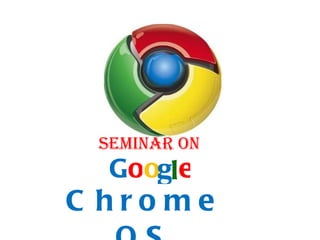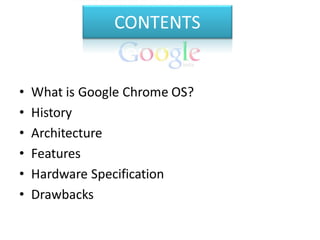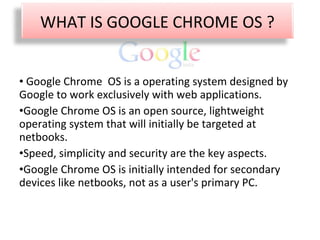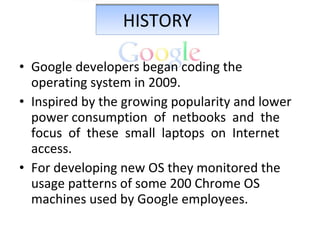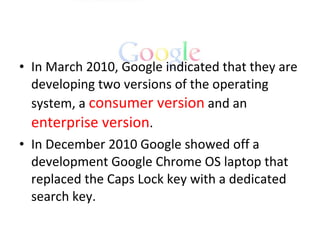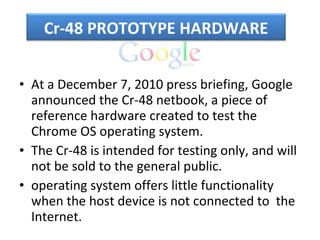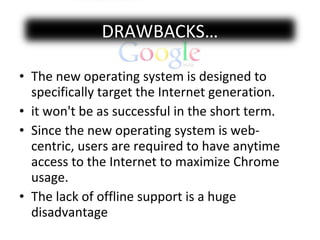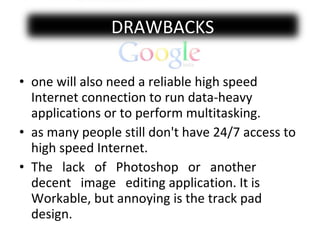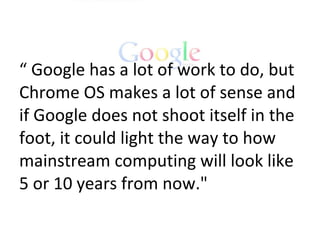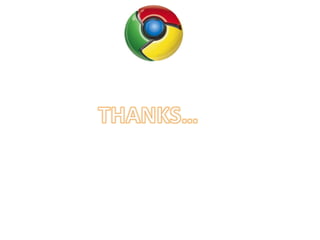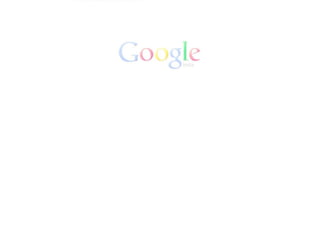An Introduction to Google Chrome OS..........
- 1. Chrome OS G o o g l e SEMINAR ON
- 3. Google Chrome OS is a operating system designed by Google to work exclusively with web applications. Google Chrome OS is an open source, lightweight operating system that will initially be targeted at netbooks. Speed, simplicity and security are the key aspects. Google Chrome OS is initially intended for secondary devices like netbooks, not as a user's primary PC. WHAT IS GOOGLE CHROME OS ?
- 4. HISTORY Google developers began coding the operating system in 2009. Inspired by the growing popularity and lower power consumption of netbooks and the focus of these small laptops on Internet access. For developing new OS they monitored the usage patterns of some 200 Chrome OS machines used by Google employees.
- 5. On November 19, 2009, Google released Chrome OS's source code as the “Chromium OS project” . Google demonstrated an early version of the operating system. On January 25, 2010, Google posted notes, images and a video of a conceptual design showing how a Chrome OS user interface might look on a tablet PC with a 5-10 inch screen.
- 6. In March 2010, Google indicated that they are developing two versions of the operating system, a consumer version and an enterprise version . In December 2010 Google showed off a development Google Chrome OS laptop that replaced the Caps Lock key with a dedicated search key.
- 7. Cr-48 prototype Beta Laptop
- 8. Firmware browser and window manager. system-level software and userland services. ARCHITECTURE
- 9. Google Chrome OS code will only be supported by Google and its partners, and will only run on hardware designed for the purpose. Google Chrome OS will run on both x86 as well as ARM chips. While Chrome OS will support hard disk drives. Google Chrome OS consumes one-sixtieth as much drive space as Windows 7. HARDWARE SPECIFICATION
- 10. At a December 7, 2010 press briefing, Google announced the Cr-48 netbook, a piece of reference hardware created to test the Chrome OS operating system. The Cr-48 is intended for testing only, and will not be sold to the general public. operating system offers little functionality when the host device is not connected to the Internet. Cr-48 PROTOTYPE HARDWARE
- 11. User Interface
- 12. Instant web Same experience everywhere Always connected Security built in Forever fresh Amazing web apps
- 13. The company demonstrated an offline version of Google Docs running on Chrome OS and announced a 3G plan that would give Chrome OS users 100MB of free data each month, with additional paid plans available from Verizon. About 60,000 Cr-48s were distributed to testers and reviewers in early December 2010. Reviews published about the Chrome OS running on the Cr-48 in mid-December 2010 indicated that while the project holds promise it still has some distance to go before being ready for market.
- 14. The new operating system is designed to specifically target the Internet generation. it won't be as successful in the short term. Since the new operating system is web-centric, users are required to have anytime access to the Internet to maximize Chrome usage. The lack of offline support is a huge disadvantage DRAWBACKS…
- 15. one will also need a reliable high speed Internet connection to run data-heavy applications or to perform multitasking. as many people still don't have 24/7 access to high speed Internet. The lack of Photoshop or another decent image editing application. It is Workable, but annoying is the track pad design. DRAWBACKS
- 16. "met the basic requirements for Web surfing, gaming, and personal productivity, but falls short for more intensive tasks". “ It's decidedly not a full-fledged alternative to the general purpose computing environments that currently ship on netbooks". “ most of Chrome OS's advantages "can be found in other software environments without having to sacrifice native applications".
- 17. “ Google has a lot of work to do, but Chrome OS makes a lot of sense and if Google does not shoot itself in the foot, it could light the way to how mainstream computing will look like 5 or 10 years from now."
- 19. FAQ About software architecture? Chrome OS’s Relationship to Android? What is Chromium OS?
Editor's Notes
- The operating systems that browsers run on were designed in an era where there was no web. So today, we're announcing a new project that's a natural extension of Google Chrome — the Google Chrome Operating System. It's our attempt to re-think what operating systems should be.
- Chrome OS will be automatically updated to the latest version.
- • The firmware contributes to fast boot time by not probing for hardware, such as floppy disk drives, that are no longer common on computers, especially netbooks. The firmware also contributes to security by verifying each step in the boot process and incorporating system recovery. • System-level software includes the Linux kernel that has been patched to improve boot performance. Userland software has been trimmed to essentials, with management by Upstart, which can launch services in parallel, re-spawn crashed jobs, and defer services in the interest of faster booting. • The window manager handles user interaction with multiple client windows much like other X window managers.
- 1)User Interface Design goals for Google Chrome OS's user interface include using minimal screen space by combining applications and standard Web pages into a single tab strip, rather than separating the two. Designers are considering a reduced window management scheme that would operate only in full-screen mode. Secondary tasks would be handled with "panels": floating windows that dock to the bottom of the screen for tasks like chat and music players. Split screens are also under consideration for viewing two pieces of content side-by-side. Google Chrome OS will follow the Chrome browser's practice of leveraging HTML5's offline modes, background processing, and notifications. Designers propose using search and pinned tabs as a way to quickly locate and access applications.
- Chrome notebooks boot in about 10 seconds and resume from sleep instantly. Your favorite websites load quickly and run smoothly, with full support for the latest web standards and Adobe Flash. All your apps, documents, and settings are stored safely in the cloud. So even if you lose your computer, you can just log into another Chrome notebook and get right back to work. Integrated Wi-Fi for home and work, and 3G for all the places in between. 100MB of free 3G data every month* on the Verizon Wireless network. Affordable data plans with no commitment required. Going online doesn't have to be scary. Chrome notebooks use advanced technology to help prevent malware and viruses from accessing your data. And you never have to lift a finger. The web evolves rapidly. Your Chrome notebook evolves with it. Every time you turn it on, it upgrades itself with the latest features and fixes. Annoying update prompts not included. Every Chrome notebook runs millions of web apps, from games to spreadsheets to photo editors. Try the latest apps from the Chrome Web Store or just type URLs into the address bar - no CDs required.
- 1) Google Chrome running within a new windowing system on top of a Linux kernel. For application developers, the web is the platform. All web-based applications will automatically work and new applications can be written using your favorite web technologies. Google's successive introduction of the popular Android and Google Chrome OS has put the company behind two open source, client-based operating systems. Microsoft CEO Steve Ballmer accused Google of not being able to make up its mind. Google has suggested that the two operating systems address different markets, mobile and personal computing, which remain distinct despite the growing convergence of the devices. Co-founder Sergey Brin suggested that the two systems "will likely converge over time". Chromium OS is the open source development version of Google Chrome OS. Chrome OS's source code was released on November 19, 2009 under the BSD license as Chromium OS.[3]

